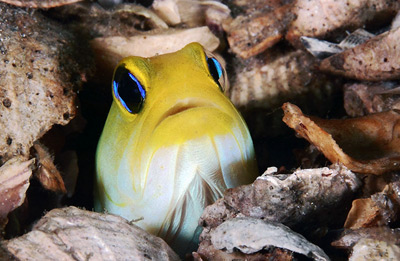When we think of compatibility problems between marine fish, what usually comes to mind is one specimen behaving outright aggressively toward another with the underlying motive of establishing territorial dominance or acquiring a meal. But sometimes incompatibility among fish has less to do with overt aggression or hungriness than, shall we say, differing “piscinalities.” Here are a few examples to illustrate my point:
Is that a predator overhead?
In some cases, pelagic fish can keep bottom-dwelling tankmates in a perpetual state of anxiety despite having no interest whatsoever in their doings. I’ve observed this in jawfish that share a tank with larger, open-swimming species that present no real threat to them, such as tangs and plankton-feeding triggers (e.g., Xanthichthys spp.). In this circumstance, a jawfish will tend to remain perpetually concealed in its burrow—with maybe just its eyes and mouth visible—rather than emerge and hover over it.
And who can blame the jawfish? For burrowing species, danger usually comes from above, and they have to decided in a fraction of a second—based on the suspect’s body shape and movement—whether something passing overhead poses a threat or not. Better to be safe than sorry. After all, a trigger-shaped fish often spells trouble!
Size differential
A similar circumstance can sometimes arise when there’s a significant size differential between tankmates. The larger fish may be a herbivore or dedicated planktivore with no design whatsoever on eating the smaller fish, but its continued presence may keep the small one on edge or in constant hiding nonetheless.
Disparate energy levels
In this situation, it’s not a specimen’s size or shape that’s unnerving, but its activity level. For example, comets (Calloplesiops spp.), which are very shy and reclusive by nature, tend to get stressed out, outcompeted at mealtimes, and remain in hiding when hyperactive tankmates are present, even if those tankmates pay the comet no mind whatsoever.
Piggies at the trough
Fish that are slower, more deliberate feeders, such as seahorses and pipefish, tend to lose out at every mealtime if they’re kept with faster, less-discerning feeders. It’s not that the faster feeders necessarily have it in for their tentative tankmates—they just don’t fool around when food is in the water. But whatever the reason, any fish that is consistently outcompeted for food is ultimately going to starve.
What have I missed?
So, fellow salties, what are some other examples of unexpected compatibility issues you’ve encountered? Let us know in the comment section below.



